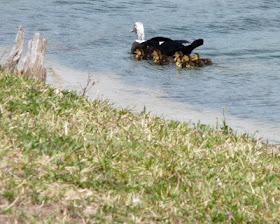It's a simply glorious early March day here in Tampa, the kind of day where you know that folks up North are happy to reach into the upper 30s and 40s while we're enjoying warm sun, cool breezes, and temps in the mid 70s. I spent the afternoon puttering around in the gardens, pulling weeds, tying up honeysuckle, and so on, and as I worked, I couldn't help but think how different things are here than they were a year ago.
In my last post, I showed some "before" pictures and talked about the plans we made as we started our landscaping projects. In future posts, I'll detail the work involved in making things happen, but for today, I'm going to show the evolution of our front gardens to make one simple point - gardening is a never-ending experiment.
As a reminder, here's the front yard a year ago, in early March 2008:

Here's the same front yard today, March 2009:

And another view:

While these aren't the best pictures for seeing detail, they do give an overall view of the changes. Here's what's currently thriving in my west-facing front gardens:
I also have some newly planted
Beach Sunflowers* that I'm hoping will take off, and several plants that aren't exactly thriving but are slowly finding their way: a
Croton bush, a
Tropical Hibiscus, and a
Pygmy Date Palm. My
Lantana Camara has been pruned way back to keep it from overgrowing its welcome (this species is not native and can be invasive if you're not careful, but oh, how it attracts the butterflies!).
Over the last year, these gardens have actually changed several times, as I learned what did and didn't work in My Florida Backyard.
Here are the front gardens after we first planted them in late March/early April 2008:


And here's what we had in mid-July 2008, after a few months of growth and the start of the rainy season (never underestimate the power of a tropical climate to make things grow!):


Sharp eyes will notice that there have been some plant changes since then! Here's what eventually didn't work out in these west-facing front gardens, for one reason or another:
- Blue-Eyed Grass* - I don't know what happened with these guys. I absolutely loved them when I found them at the Home Depot nursery(!) and realized they were natives. I planted them all over the place, including in my front gardens, and the were simply gorgeous for about two months. After that, they turned brown and almost seemed to "rot" from the center out. I ended up yanking most of them and replacing them with something else. I still have a few in my back garden, and I'm waiting to see what spring might do for them.
- Oleander - Actually, the oleander in my back gardens is doing all right, if not thriving. I'm hoping the rainy season will bring back the pale pink flowers we had last year. But the one in the front garden just didn't thrive and had to go.
- Mondo Grass - My guess is that these just got too much sunlight in a west-facing garden. This was a case of gardener's error, because I just didn't read the light specification for these plants.
- Saw Palmetto* - Actually, this did fine up front, but the plumbago on either side basically just grew right over top of it. I transplanted this to my back garden, where it continues to limp along. It's a slow-grower and didn't like being transplanted, but it has some new growth and I think will be fine once the warm rainy season arrives.
- Sparkleberry* - Ah, this one broke my heart. This bush was listed in my butterfly gardening book as a great native plant to have, and I was looking forward to the little white flowers it promised. But, alas, it was not to be, because this plant just did very poorly and eventually died. I'm betting it was something I did, but I just don't know what.
By late fall, I had discovered a few more surprises in my gardens. By then, I'd pretty much determined what would work and what wouldn't (although I still hadn't found the solution under the tree out front), but now the Muhly grass began to show its amazing fall colors (never let anyone tell you we don't have noticable seasons here in Florida!).


Again, sharp eyes will notice that we desperately needed to do some weeding, but summertime in Florida is really not gardening time. About 10 minutes outside (and that includes mornings and evenings) is about all you can stand, so we let things get a bit overgrown until the weather had cooled down. At any rate, you can see that the Muhly grass offers fantastic rewards in the fall, which I really hadn't expected.
Since that day in October, we have refreshed the mulch and weeded quite a bit. I am also trying the Beach Sunflowers under the tree now and am eager to see how it will do (it's only been in the ground 10 days but already has some flowers). We are in the "peak of the dry", as Steve Irwin would have said, so my plants will grow slowly over the next few months.
All in all, I can't help but feel pleased with our accomplishments. I've learned a lot about what I can and can't grow over the last year, and I look forward to seeing how the right plants will continue to thrive as the next year passes. The experiment continues!
(*Asterisks indicate plants native to Florida. Watch future posts for more info on Native Florida plants.*)































